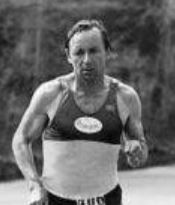

Bernd Heinrich has achieved global notoriety for his professional career as a Physiological Ecologist and Entomologist. Recently retired as a professor of Zoology at the University of Vermont, he is generally considered the world’s leading authority on topics as diverse as the physiology of bumblebees and the sociology of ravens. Heinrich holds a Ph.D. in Zoology, has been both a Guggenheim Fellow and a Harvard Fellow, and has been awarded two honorary doctorates. He has published over 100 scholarly papers, over 50 professional book reviews, over 35 book chapters, over 70 articles for magazines and newspapers as diverse as Outside, Runners World, and the New York Times, and has authored over 15 books on various aspects of the natural world. Some of his popular writings in recent years have explored the physiological propensity of humans toward long distance running.
But none of that is why he is only the second American man, behind the legendary Ted Corbitt, to enter the Ultrarunning Hall of Fame. His world-class ultra career was short, but it left a sweeping impact on the sport. Heinrich didn’t get serious about competitive running until his late 30’s. After winning the masters division of the Boston Marathon in 1980 just after turning 40, he decided to move up in distance and immediately achieved success, setting an American Masters record 3:03:56 for 50k in his first ultra. The following year, in only his second ultra, he ran what many observers consider the race of his life, becoming an instant national legend. The preeminent road ultra in the country was the AMJA combined 50 Mile/100k in Chicago. Barney Klecker, who had set the World 50 Mile record of 4:51:25 the previous year, was back and all eyes were on him. He won again, in 5:05:04, but now the gaze of all eyes switched to the unknown who was hot on his tail, 41-year old Bernd Heinrich. Heinrich broke the World Masters Record with a second-place 5:10:12, and then shocked everyone by deciding at the last minute to continue on for the full 100k distance. His final time of 6:38:20 established both a new World Masters Record and a new absolute Open American Record. The latter would stand for 14 years.
Two years later, running uncontested in a small 24-hour track race in 90-degree daytime heat, Bernd Heinrich set a new American Record of 156 miles, 1388 yards. This one would hold up for 7 years. For the next two years he continued his racing policy of one serious ultra per year. Next after the 24-hour came the track 100 mile, where he ran 12:27:01 for a new absolute American Record by almost a half hour. Though subsequently surpassed by Rae Clark on the roads, it still stands today, over 23 years later, as the American Track Record. The last of his national marks came the following year, as he ran 7:00:12 for 100k on the track to become and first and only man to hold both the track and road versions of the same ultra distance record. That one currently remains intact as well.
After less than a half-decade, Bernd Heinrich ended his competitive ultra career, focusing more on his professional one. He returned to ultras many years later, at the age of 61, to set a U.S. Masters 60-64 age-group Record of 6:39:55 for 50 miles.
Ultrarunning History article on Bernd Heinrich
